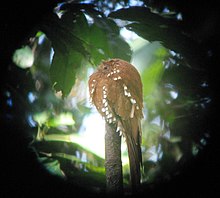| Rufous potoo | |
|---|---|

| |
| Conservation status | |
 Least Concern (IUCN 3.1) | |
| Scientific classification | |
| Domain: | Eukaryota |
| Kingdom: | Animalia |
| Phylum: | Chordata |
| Class: | Aves |
| Clade: | Strisores |
| Order: | Nyctibiiformes |
| Family: | Nyctibiidae |
| Subfamily: | Nyctibiinae |
| Genus: | Phyllaemulor Costa, Whitney, Braun, M, White, ND, Silveira & Cleere, 2017 |
| Species: | P. bracteatus |
| Binomial name | |
| Phyllaemulor bracteatus (Gould, 1846) | |

| |
| Synonyms | |
|
Nyctibius bracteatus Gould, 1846 | |
The rufous potoo (Phyllaemulor bracteatus) is a species of bird in the family Nyctibiidae. It is the only member of the genus Phyllaemulor. It is found in Brazil, Colombia, Ecuador, French Guiana, Suriname Guyana, Peru, and Venezuela.
Taxonomy and systematics
A 2009 publication suggested that the rufous potoo differed enough in cranial structure and genetic divergence from other potoos (in the genus Nyctibius) that it deserved to be in its own genus, Phyllaemulor. This genus was officially described by Costa et al. in 2017. As of 2022, the BirdLife International Handbook of the Birds of the World, the International Ornithological Committee (IOC), and the South American Classification Committee of the American Ornithological Society (AOS-SACC) have followed in reclassified it into Phyllaemulor. The Clements taxonomy retains it in genus Nyctibius.
The rufous potoo is monotypic.
Description
The rufous potoo is 21 to 25 cm (8.3 to 9.8 in) long and weighs 46 to 58 g (1.6 to 2.0 oz). The rufous potoo is the smallest member of its family, and the most unusually colored. It is overall a deep orange-red with large white spots; the color is paler on the throat. The spots on the upper belly have a thin black border and the tail has darker bars. It has long bristles in the loral region. It resembles a dead leaf, an impression heightened by its vertical posture on a roost, where it gently sways.
Distribution and habitat
The rufous potoo is found in Amazonia from Venezuela south to Peru and east into Brazil, French Guiana, and Guyana. The AOS-SACC also records it as "Hypothetical" in Bolivia. It is known only from scattered locations though it probably occurs more widely than them. It primarily inhabits forests on nutrient-poor soils such as those with high sand content and those in blackwater regions. It is mostly found in the under- and mid-stories of both primary and mature secondary terra firme forest. It also occurs in swampy palm forests of the Campinarana. In elevation it ranges only as high as 550 m (1,800 ft).
Behavior
Feeding
The rufous potoo forages by sallying from a perch to capture flying insects, and usually returns to the same perch. It feeds on insects of at least five orders.

Breeding
The rufous potoo's nesting season apparently spans from September to possibly February. Very few nests are known. The "nest" is unusual: The bird lays its single egg on top of a broken stub.
|
Songs and calls Listen to rufous potoo on xeno-canto |
Vocalization
The rufous potoo's song is "a soft, rapidly descending series of roughly 10–15 notes: “bu-bu-bu-bu-bu-bu..." or "whooo, tooo, tooo, tooo, tooo, tooo, tooo, tooo, tooo, tooo, tooo, toot" that resembles the songs of some small owls. It mostly, and perhaps exclusively, sings during a few days around the full moon. It also makes "wup" or "urt" calls.
Status
The IUCN has assessed the rufous potoo as being of Least Concern, though its population is not known and is believed to be decreasing. It is "robably not seriously threatened as long as extensive areas of Amazonian forest remain intact".
References
- ^ BirdLife International (2016). "Rufous Potoo Phyllaemulor bracteatus". IUCN Red List of Threatened Species. 2016. Retrieved 17 October 2021.
- ^ Gill, F.; Donsker, D.; Rasmussen, P. (July 2021). "IOC World Bird List (v 11.2)". Retrieved July 14, 2021.
- ^ Remsen, J. V., Jr., J. I. Areta, E. Bonaccorso, S. Claramunt, A. Jaramillo, D. F. Lane, J. F. Pacheco, M. B. Robbins, F. G. Stiles, and K. J. Zimmer. Version 24 August 2021. Species Lists of Birds for South American Countries and Territories. https://www.museum.lsu.edu/~Remsen/SACCCountryLists.htm retrieved August 24, 2021
- Costa, T.V.V.; Donatelli, R.J. (2009). "Osteologia craniana de Nyctibiidae (Aves, Caprimulgiformes)". Papéis Avulsos de Zoologia (in Portuguese and English). 49 (21): 257–275.
- Costa, Thiago V. V.; Whitney, Bret M.; Braun, Michael J.; White, Noor D.; Silveira, Luís Fábio; Cleere, Nigel (2017). "A systematic reappraisal of the Rufous Potoo Nyctibius bracteatus (Nyctibiidae) and description of a new genus". Journal of Ornithology. 159 (2): 367–377. doi:10.1007/s10336-017-1511-2. ISSN 2193-7206.
- Gill, Frank; Donsker, David; Rasmussen, Pamela, eds. (January 2022). "Frogmouths, Oilbird, potoos, nightjars". IOC World Bird List Version 12.1. International Ornithologists' Union. Retrieved 8 July 2022.
- "A classification of the bird species of South America. Part 2". www.museum.lsu.edu. Retrieved 2022-08-25.
- Clements, J. F., T. S. Schulenberg, M. J. Iliff, S. M. Billerman, T. A. Fredericks, J. A. Gerbracht, D. Lepage, B. L. Sullivan, and C. L. Wood. 2021. The eBird/Clements checklist of Birds of the World: v2021. Downloaded from https://www.birds.cornell.edu/clementschecklist/download/ Retrieved August 25, 2021
- ^ Cohn-Haft, M. and G. M. Kirwan (2020). Rufous Potoo (Nyctibius bracteatus), version 1.0. In Birds of the World (J. del Hoyo, A. Elliott, J. Sargatal, D. A. Christie, and E. de Juana, Editors). Cornell Lab of Ornithology, Ithaca, NY, USA. https://doi.org/10.2173/bow.rufpot1.01 retrieved October 17, 2021
External links
- Photos, videos and observations at Cornell Lab of Ornithologys Birds of the World
- Rufous potoo photo gallery at VIREO (Drexel University)
- Photo; Article mindobirds.com
| Taxon identifiers | |
|---|---|
| Nyctibius bracteatus |
|







